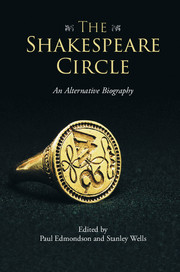Book contents
- Frontmatter
- Contents
- List of illustrations
- List of contributors
- Preface and acknowledgements
- General introduction
- Part I Family
- Part II Friends and Neighbours
- Part III Colleagues and Patrons
- 18 His fellow dramatists and early collaborators
- 19 His theatre friends: the Burbages
- 20 His fellow actors Will Kemp, Robert Armin and other members of the Lord Chamberlain's Men and the King's Men
- 21 His literary patrons
- 22 His collaborator George Wilkins
- 23 His collaborator Thomas Middleton
- 24 His collaborator John Fletcher
- 25 His editors John Heminges and Henry Condell
- Closing remarks
- Afterword
- Index
- References
18 - His fellow dramatists and early collaborators
from Part III - Colleagues and Patrons
Published online by Cambridge University Press: 05 November 2015
- Frontmatter
- Contents
- List of illustrations
- List of contributors
- Preface and acknowledgements
- General introduction
- Part I Family
- Part II Friends and Neighbours
- Part III Colleagues and Patrons
- 18 His fellow dramatists and early collaborators
- 19 His theatre friends: the Burbages
- 20 His fellow actors Will Kemp, Robert Armin and other members of the Lord Chamberlain's Men and the King's Men
- 21 His literary patrons
- 22 His collaborator George Wilkins
- 23 His collaborator Thomas Middleton
- 24 His collaborator John Fletcher
- 25 His editors John Heminges and Henry Condell
- Closing remarks
- Afterword
- Index
- References
Summary
Around the time that Shakespeare was putting a dog on stage in The Two Gentlemen of Verona, a contemporary was accusing him of being an animal. Though Ben Jonson would later call him the ‘Sweet swan of Avon’ (Oxford Shakespeare, p. lxxi) in a commendatory poem published in the First Folio, the first reference to Shakespeare in print called him a crow and a tiger. Alongside these animal references, Shakespeare also found himself called a puppet, an upstart and ‘an absolute Johannes fac totum’ (which means something like ‘jack of all trades, master of none’ or ‘know-it-all’) (Greene's Groatsworth 1592, pp. 83–5). This was not only the first recorded response to Shakespeare's work, but the first appearance of Shakespeare in print. Shakespeare had clearly been writing work for the theatre and his earliest sonnets may well have already circulated in manuscript, and much of this early work would later be printed for book readers. He nevertheless first appeared in a book as the subject of discussion, rather than its author. Though he would later come to be venerated by playgoers, readers and actors, this first appearance makes clear that he could be an object of vitriol to at least one of his contemporaries, an untrustworthy beast operating beyond his powers who should be avoided by other playwrights. Why might Shakespeare appear that way to his early contemporaries?
The pamphlet attacking Shakespeare was called Greene's Groatsworth of Wit. It purported to be by the fiction-writer and playwright Robert Greene, but is now more generally thought to have been written by the writer and printer, Henry Chettle (Jowett, 1993). Because they have been drawn to their subject through their love of Shakespearian drama, Shakespeare scholars, and particularly biographers, have tended to assume there must be something wrong with the Groatsworth vision of an imperfect, parvenu Shakespeare whose work was provocative to contemporaries. Indeed, the Groatsworth has been as threatening to Shakespeare scholarship as Shakespeare seems to have been for the Groatsworth author. Schoenbaum calls the debate generated by Groatsworth ‘wearying’ (Schoenbaum 1970, p. 51), quoting John Semple Smart's opinion that ‘This passage from Greene has had such a devastating effect on Shakespearian study that we cannot but wish it had never been written or never discovered’ (Smart 1928, p. 196). Park Honan, a scholar not given to rhetorical excess, describes it as ‘virtually a rape of Shakespeare’ (Honan 1998, p. 158).
- Type
- Chapter
- Information
- The Shakespeare CircleAn Alternative Biography, pp. 235 - 247Publisher: Cambridge University PressPrint publication year: 2015



